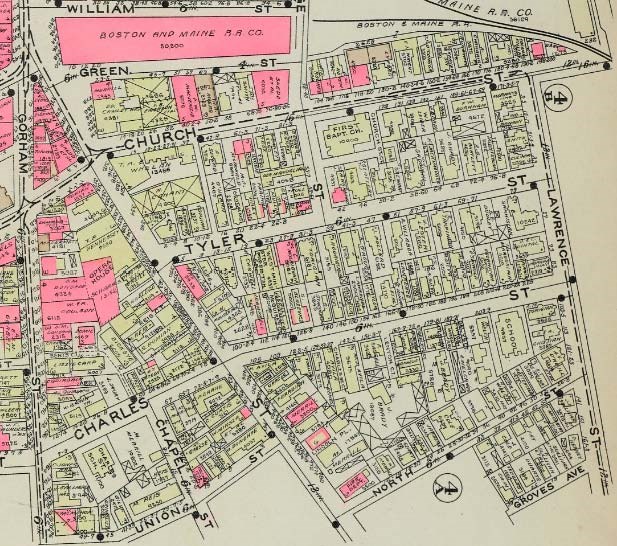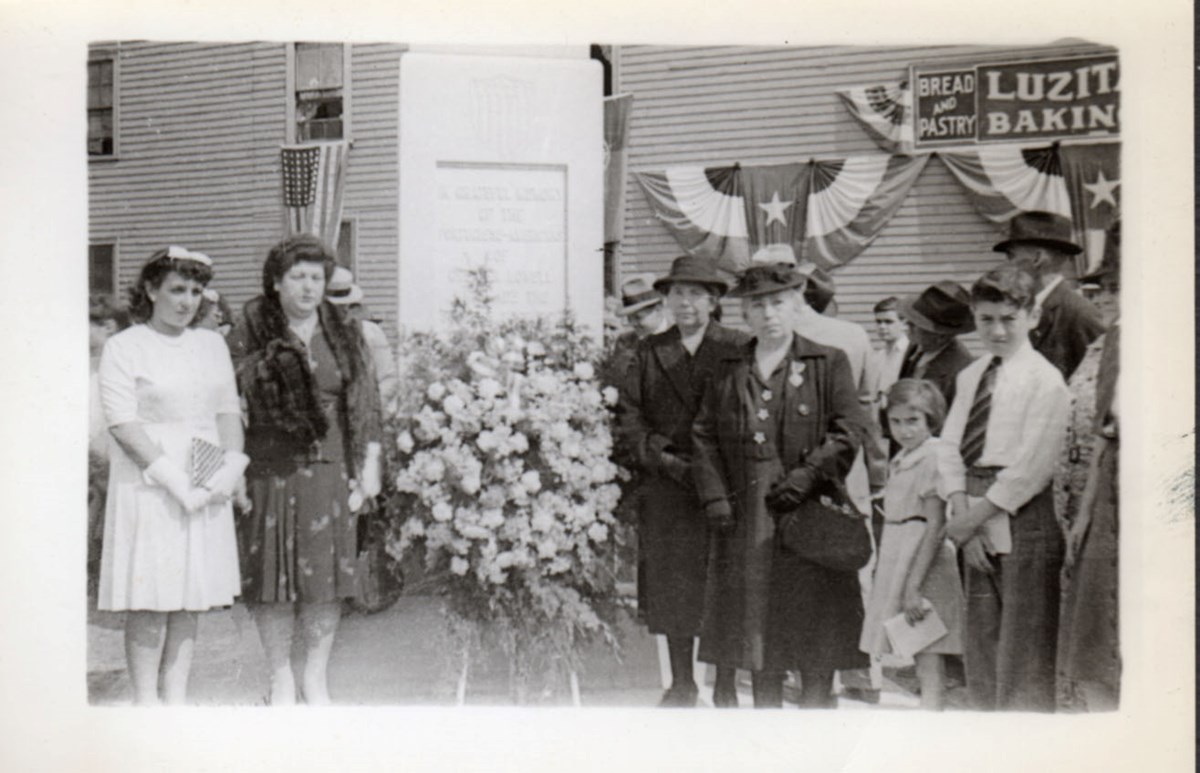By 1930 the city’s population of Portuguese born overseas dropped to fewer than 1,100, having peaked about a decade earlier to nearly 2,000. For most Portuguese in Back Central factories remained the major employer. In 1930, for example, in a sampling of Portuguese living in a group of tenements in the 100 block of Charles Street, where all rented their residences, of the 21 adults who had jobs, 20 were wage earners and only one, John F. Pitta from Madeira, the proprietor of a bakery, owned a business. The textile industry remained the major employer; nine of the 20 wage earners held jobs in textile mills. Among the other important industries in which the Portuguese were employed were shoe manufacturing, leather goods production (in tanneries), and the building trades.
Although the Portuguese immigrant population declined in the 1920s, the number of Portuguese owning their homes increased. At the beginning of the decade 87 Portuguese born overseas owned their residence. But by 1930 the number had risen to 130, a growth of nearly 50 percent. As shown in Table 5, several of the city’s immigrant groups followed a similar trend with homeownership rising at roughly the same rate. Of immigrant homeowners, however, the Portuguese, in 1930, had the lowest percentage (23%) of naturalized citizens compared to Poles (57%), Greeks (55%), and Italians (52%). Ten years later the number of Portuguese homeowners who became U.S. citizens greatly increased, with a percentage of 56%, but they continued to lag in relation to Poles (75%), Greeks (87%), and Italians (81%).
Table 5: Home Ownership in Lowell of Select Immigrant Groups, 1920-1940
1920 Number of Homeowners (Percent of Population) | 1930 Number of Homeowners (Percent of Population) | 1940 Number of Homeowners (Percent of Population) | |
Greeks | 89 (2.38%) | 205 (10.51%) | 149 (8.58%) |
|---|---|---|---|
| Poles | 123 (5.35%) | 268 (16.67%) | 214 (15.31%) |
| Portuguese | 87 (4.48%) | 130 (12.1%) | 131 (13.88%) |
| Italians | 53 (12.3%) | 56 (16.67%) | 58 (34.02%) |
Notes: The considerable decline in homeownership among Greeks by 1940 was partly the result of the City of Lowell taking and demolishing, by eminent domain, a number of Greek-owned properties in the Acre neighborhood for a large-scale public housing project.
Although small in number, Lowell’s Italian immigrants possessed one of the highest percentages of homeowners. And nearly 50% of Italians who owned their homes lived in Back Central. Three notable characteristics among Italian-born immigrant homeowners that standout from other immigrant owners include: (1) their rates of naturalization (52% by 1930) were among the highest in the city; (2) a low percentage (about 4%) worked in textile mills; (3) a slightly larger percentage (4%) owned their own businesses.
Of Portuguese immigrant homeowners in Lowell, two other characteristics standout in relation to the Back Central neighborhood: First, in 1920 over 40 percent of Portuguese-owned homes (a total of 36 homes) were in Back Central. Of these residences, over half were located in the northernmost section of the neighborhood, where, in 1910, the highest concentration of the city’s Portuguese lived. A decade later, in 1930, however, the number of Portuguese homeowners in Back Central climbed to 49 and this included more properties to the south, several blocks away from the original “Portuguese colony.” But reflecting a trend that grew in the ensuing years, a rising number of Portuguese chose to live in other neighborhoods, including South Lowell and the more affluent Highlands neighborhood, which were much less densely urbanized and had more single-family homes than Back Central.
 Image by Center for Lowell History
Image by Center for Lowell History
This detail from the 1924 Atlas of the City of Lowell shows the densely urbanized Back Central area around Charles Street. Most the buildings here were constructed prior to the Civil War. By the 1920s an increasing number of Portuguese owned various dwellings and tenements on Charles Street.
The second notable characteristic of the early home-owning Portuguese immigrants in Back Central was the low rate of naturalization. While the percentage citywide of all Portuguese homeowners who had become U.S. citizens by 1930 was about 23%, the Back Central Portuguese who owned their own property and were naturalized amounted to just 12%, suggesting that the Portuguese who remained in their “original enclave” tended to hold onto citizenship of their native land and retained close ties to their native culture. But this too changed over the course of the 1930s. By 1940, nearly 40% of Portuguese immigrant homeowners in Back Central were naturalized. While still below the overall 56% of naturalized Portuguese property holders in Lowell, the number of those becoming citizens of their adopted land was on the rise.
Unlike the First World War, when the majority of Back Central’s Portuguese who served in the military and fought overseas were first generation immigrants, in the Second World War the majority in the armed forces were born in Lowell. This included Charles A. Pereira, one of the nation’s first casualties following the American amphibious landing in North Africa in 1942. Like many other Portuguese young men in the military, Pereira’s parents were Azorean immigrants, leaving the island of Graciosa around 1910 and settling in Lowell, where they obtained jobs in the Boott Cotton Mills. They lived many years in an apartment on Charles Street, where Charles and his sister, Mary, grew up. A popular athlete, Charles graduated from the Butler Junior High School and, prior to enlisting in the U.S. Army in early 1942, he worked as a truck driver and was engaged to be married to Beatrice Abreau, a neighbor on Charles Street. After his death, a number of Portuguese approached the city council to create a memorial for Pereira and others from Lowell who gave their lives for their nation. Dedicated in 1943, this was the city’s first World War II memorial commemorating those who served overseas.
 Image by Herbert Pitta Jr. Collection
Image by Herbert Pitta Jr. Collection
On Memorial Day of 1944, city officials and Congressional Representative Edith Nourse Rogers dedicated a granite monument in Charles A. Pereira Park to those from Lowell who died serving their country in the Second World War. This photograph shows some of the city’s Portuguese women, including Jessuina Pitta, who led in establishing this monument.
While dozens of young Portuguese-Americans were serving in the military in Europe and the Pacific, the home front experienced a wartime economic boom. Defense industries, notably in textiles, munitions, and leather goods, employed thousands in Lowell. As in other immigrant families, young Portuguese women entered the workforce in growing numbers. The downtown and other commercial sections of the city, including Back Central, bustled despite wartime rationing.
But this prosperity, enjoyed by some Lowell residents, proved fleeting. Even before the end of the war, one of the city’s major munition manufacturers, with a large plant in South Lowell, ceased operation. A number of elected city officials raised concerns over looming post-war economic prospects. These worries proved well founded for, by early 1946, Massachusetts had fewer job opportunities than at any time before the war, an especially pressing problem with the many returning veterans. Over the next decade Lowell had among the highest unemployment rate in the state, climbing above 15 percent by 1958. Conditions for textile workers were even worse with nearly one-third of this workforce jobless.
For many Portuguese in Back Central the decline in older manufacturing industries, including textiles, shoes, and leather goods, contributed to the financial stress of families. As shown in Table 6, in 1950, in textiles alone, over 60 percent of wage earners in the neighborhood continued to rely on this industry for their livelihood. But the closing of the Boott Cotton Mills in 1954 and the Merrimack Mills in 1957, the last of the early major cotton manufacturers in Lowell, reduced the number of the city’s textile jobs by about one-third. To some extent, those Portuguese who were born overseas but became U.S. citizens (over 60 percent based on a sampling in Back Central by 1950—see Table 6) were aided by state-provided unemployment compensation. But, especially for older members of the Portuguese community, finding new jobs was increasingly difficult.
In fact, with stringent immigration quotas in place since the 1920s, and with only a small number of new Portuguese immigrants settling in Lowell, the average age of Back Central’s Portuguese born overseas reached 55 years by 1950. Moreover, the neighborhood’s aging Portuguese population was declining as a result of deaths or from those who decided to move to other locales. From this same sampling (in Table 6), but examining one street, Chapel Street, where the largest concentration of Back Central’s Portuguese resided in 1940 and 1950, there were, over the course of this decade, 26 men and women born overseas (of a total of 44) listed on Chapel Street in 1940 who no longer resided here ten years later.
All of those who departed from Chapel Street by 1950 had been renters on this street in 1940. By contrast, the five Portuguese who owned their Chapel Street homes in 1940 were still living at the same address in 1950. Census takers recorded only eight of the Portuguese who rented on Chapel Street in 1940 as still residing here a decade later. And overall there were fewer Portuguese residing on Chapel Street: The census recorded 44 in 1940 but the number dropped to 32 by 1950. While this turnover of nearly 60 percent of renters was not unusual in Lowell’s Back Central, nor was the relative stability of Portuguese home owners in this neighborhood, the number of Portuguese in Back Central, whether born overseas or in the United States, was in decline.
Table 6: Back Central Residents Listed as Born in Portugal: A Sampling from the Federal Census, 1950
- Number of Residents: 73
- Male/Female:37 /37
- Average Age: 55 years
- Wage Earners (those working outside the home): 39 (54%)
- Wage Earners in Textile Industry: 24 (61.5%)
- Business Owners: 2
- U.S. Citizens/Citizens of Portugal: 36 (63%) / 27 (37%)
Notes: For this sampling, the streets selected in Back Central include Central, Chapel, Union, Elm, Cherry, and Auburn. It is notable that by 1950 there were no residents listed as being born in Portugal and living on Charles and North streets, which had been the center of the “Portuguese colony” by 1910. This sampling of 73 residents includes all of those born in Portugal, Brazil, and the Atlantic Islands; only one, a male, Joseph Gouveia, age 47, was listed as being born in Brazil. All others were listed as being born in Portugal.
